![]() 1st Battalion 22nd Infantry
1st Battalion 22nd Infantry ![]()
The Datu Ali Expedition -1905
![]()
Campaign Streamer awarded to the 22nd Infantry for its service in Mindanao 1904-1905
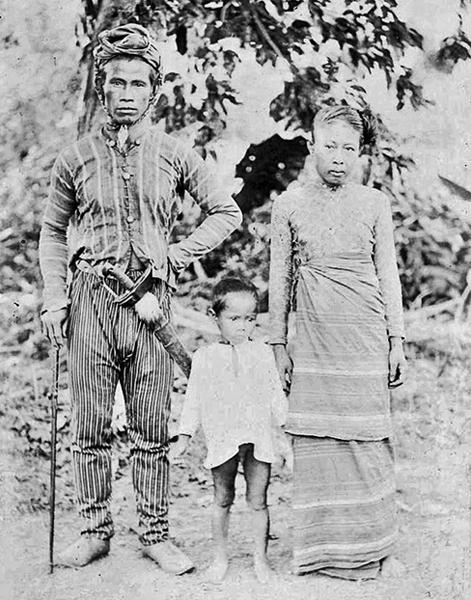
Datu Ali, brandishing his kris most prominently, in a portrait with one of his wives and son.
Photo courtesy of the website:
MOROLAND
The History of Uncle Sam and the Moros
1899-1920
Datu* Ali was the last, and most
formidable Moro chieftain to oppose American rule
on the island of Mindanao. For nearly two years, operations
against Ali were carried out by
several formations of the US Army and the Philippine
Constabulary.
* The word "Datu" was
used to describe leading members of Moro royalty. The Sultan was
the highest authority in Moro society, followed by the Datu's.
Depending upon what level
of prestige an individual Datu occupied, the word could be
translated to mean prince,
duke, count or baron. Period spellings of the title included
"Datuk", "Dato" and "Datto".
Ali eluded capture until finally
surprised and killed by a Provisional Company of the 22nd
Infantry
led by Captain Frank R. McCoy, the Aide De Camp of General
Leonard Wood.
Colonel John White, who spent 15
years as an officer in the Philippine Constabulary,
sets the stage with a description of Ali's home land -- the
Cotabato District of Mindanao:
EARLY in June, 1904, General
Wood called upon Colonel Harbord to organize a Constabulary in
the District of Cotabato,
the largest and perhaps least-known division on the Moro
Province, where a prominent Moro chief named Datu Ali
had recently started on the war-path. Colonel Harbord relieved me
as adjutant for assignment as Senior Inspector of the
Constabulary
of Cotabato with instructions to recruit as rapidly as possible
among the tribes of friendly Moros and organize a force that
could be used as Scouts,
accompanying expeditions of United States troops against the
hostiles scattered throughout the length and breadth of the
valley of the
Rio Grande de Mindanao. Cotabato District consisted of the valley
of this broad, deep, muddy stream, a valley some two hundred
miles long
and from ten to fifty broad. This watershed contained large areas
of swamp and lakes, with villages of Maguindanaw Moros sparsely
scattered
along the banks of the river and its tributaries or amid the
almost trackless and impassable swamps. Back of the valley rose
forbidding ranges
of mountains, culminating in Mount Apo, eleven thousand feet in
height. In the jungles of these mountains were legendary pagan
tribes,
rejoicing in the names of Tirurayes, Manobos, Bagobos, Bilanes,
and many more such.
The Maguindanaws were the
largest tribe of Moros. They controlled practically the whole of
the mainland of Mindanao.
Although more agricultural and less piratical than their cousins
in Sulu, they held almost as tightly to their ancient privileges
of slavery
and control of the pagan tribes, while the situation of their
bamboo villages and earthen cottas (forts) on the shores of the
mountain lakes,
as in Lanao, or amid the swamps, as in Cotabato, made campaigning
against those chiefs who refused to recognize the authority
of the United States both difficult and costly.
The Spaniards had sent many an
expedition up the Rio Grande, and with shallow-draft gunboats had
shot their way into the heart
of Cotabato District. They obtained concessions from Datu Utu,
the Maguindanaw chief who then ruled that swampy land. But the
control
exercised by the Spaniards extended little if any further than
the range of cannon shot from the toy men-of-war, while the price
they paid in men
and blood for even such victory was heavy. Furthermore, every
inch of ground wrested from the Maguindanaws must be controlled
by stone-fort
or blockhouse. When, in 1899, the Spaniards withdrew before the
advancing Americans from the north, anarchy reigned in Cotabato.
Datu Utu had gone to the voluptuous reward of good fighting
Moros, and his nephew, Datu Ali, ruled in his stead. ¹
The Annual report to the War
Department for 1904 included the following passage which
specifically mentioned
Datu Ali and related the difficulties associated with a Moro
chieftain like him:
In the upper Cottabato Valley,
Dato Ali is out with a small following. Ali has always been a bad
character, a gambler, a slave dealer, and has declared
that he will not obey the law, especially the slave law. He and
his brother, Djimbangan were the principal leaders in the sack of
Cottabato in 1899.
As long as he was not interfered with in his slave trade and
oppressing others he was apparently friendly, but as soon as
steps were taken to bring to an end
the revolting conditions existing in his section, he broke out in
armed defiance of authority, collected about 3,000 followers, and
constructed at Serenaya a large fort, etc.
In March these forces were defeated and the works destroyed, and
Ali, with a few followers, went into the up-river country, where
he is at this time. Eighty-five pieces
of ordnance were taken from the Serenaya fort, 21 of them large
cannon from 5 ½ - 3 inches caliber. In May he ambushed F
Company, Seventeenth Infantry,
with disastrous results to the company and considerable loss to
himself.
All's party is the only outfit of Moros now openly hostile and it is being vigorously followed by troops and scouts.
The country he is operating in
is of the most difficult description, consisting of lakes,
rivers, and immense swamps, covered with tropical vegetation.
There is little
solid ground; trails are muddy and difficult and bordered by
grass from 10 to 15 feet high—everything combines against
the pursuit. It is not believed that there will be
in future any very serious resistance to authority on the part of
Moros, but there will be constant work of a police character,
which will require the use of troops and constabulary.
The Moro chiefs do not like our occupation of their country,
because it means an end of the disgustingly brutal exercise of
authority which characterizes their conduct of affairs.
The following passages
illustrate the problems the US Army was having with Datu Ali.
They are taken from the Annual Reports to the War Department, and
indicate encounters
with Ali during the year 1904:

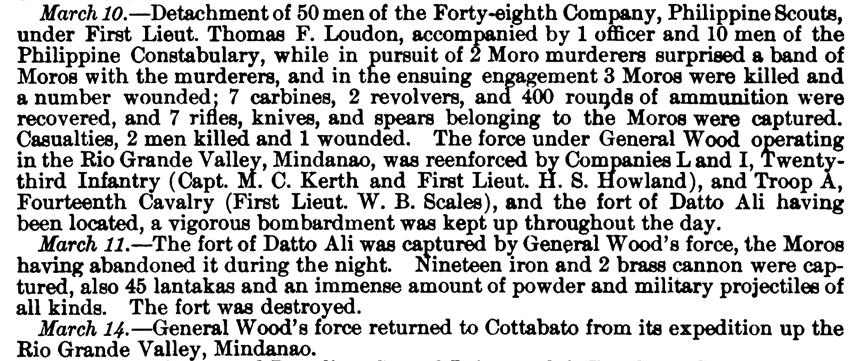




In his report to the War
Department for the fiscal year ending June 30, 1905 Major General
Leonard Wood,
Commander of the Department of Mindanao in the Philippines summed
up the problem of Datu Ali:
Dato Ali is in hiding with a
small following somewhere in the interior of the island of
Mindanao, east of Lake Liguasan. He has been quiet and has
committed
no hostile act since last October, and his people to the number
of fifteen to twenty thousand have come in, settled along the Rio
Grande, and gone to work.
Conditions among the remaining non-Christians have continued
favorable, and great progress has been made in establishing
friendly relations with them and
in putting into operation a simple system of control through
their headmen. The Moro outbreaks are largely due to the actions
of fanatical Arab priests, of a
class which is a disturbing element throughout the East. These
difficulties and disturbances are growing less frequent and less
dangerous, as, in every instance,
failure and heavy losses to the Moros have been the result, and,
while occasional troubles may be expected, they will occur less
and less frequently,
and will be easily handled.
The following is the short, but
official narrative of the operation which put an end to Ali's
activities,
as recorded by CPT Daniel Appleton, in the 1922 Regimental
History.
The Datu Ali Expedition
Just as the regiment had completed preparations
for the return to the United States, and the officers and men
were beginning to anticipate
the joy of being once more in their native land, affairs took a
sudden turn in the other direction, and the following order,
quoted in full
on account of its intense interest, again placed the regiment in
line for further active service in the Philippines.
HEADQUARTERS, DEPARTMENT
OF MINDANAO, Zamboanga, Mindanao, P. I.,
October 5, 1905. Strictly Confidential.
The Department commander
is preparing an expedition to surprise and capture Datu Ali. In
view of the excellent service
and experience of the 22nd Infantry, he has selected it to
furnish the major portion of the expedition, which will be
commanded
by Captain F. R. McCoy, A. D. C., he being the only officer in
the department who has been over the route decided on.
He directs that for this hard and important work, one first
lieutenant, two second lieutenants and one hundred picked men be
selected
as were those forming the original provisional company, armed and
equipped as at the end of their tour in the Rio Grande valley,
and be prepared to board the Sabah on the morning of the 13th
inst, at Camp Overton. The necessary medical attendance and
supplies
will be furnished, the supplies to be put in packages not
exceeding forty pounds. One hundred rounds of extra rifle
ammunition (1,903) per man,
and forty rounds of pistol ammunition will be taken. Field and
travel rations will be prepared for you at Camp Overton or
Zamboanga.
Squad boxes with extra clothing, etc., may be taken aboard ship
to leave at base.
Bring, if possible, one
hundred picked cargadores; if not, wire deficiency and it will be
made up here. Tomas Torres,
civil interpreter, will accompany. The destination of these
troops, further than Camp Overton, will not be made known
to even the officers with them. Acknowledge receipt by wire.
Very respectfully,
DANIEL, H. BRUSH, Lieut. Colonel, Inspector General,
Acting Military Secretary.
In accordance with this confidential
memorandum, a provisional company of the 22nd Infantry was again
organized on October 9, 1905.
Following are the names of the officers assigned to this company:
First Lieutenant Solomon B. West, Commanding.
Second Lieutenant Philip Remington.
Second Lieutenant B. B. McCroskey.
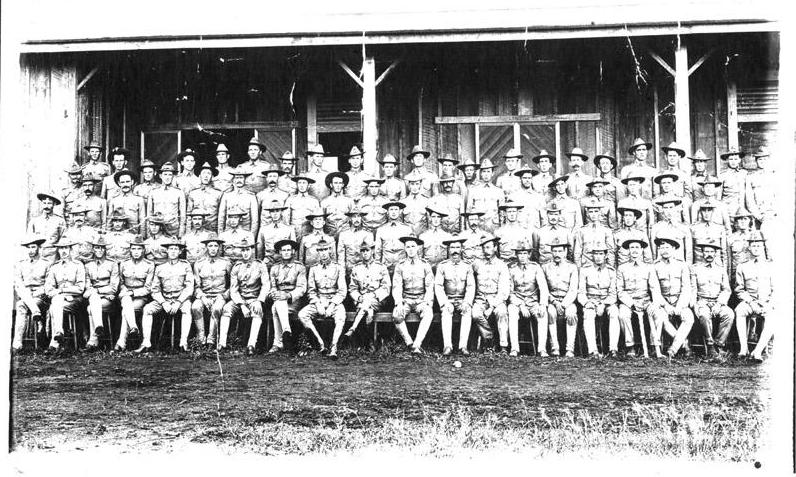
The Provisional Company of the 22nd Infantry formed for the Datu Ali expedition
Photo courtesy of Robert Hart whose father
Grover Hart was a member of the Provisional Company.
Private Hart is in the front row, fourth from the left.
|
Two soldiers identified
from the above photo of the Left, Private Grover Hart Company G Right, 2nd Lieutenant Benjamin
B. McCroskey |
|
The provisional company left Camp Keithley at
4:30 p. M., October 11, 1905. At this time nothing definite was
known of Datu Ali's whereabouts,
though he was generally thought to be on his ranchiera on the
Malola river.
In order to avoid any possibility of encountering Ali's spies,
the expedition proceeded to Digas, on the gulf of Davao, landing
at Digas on October 16.
At this point a detachment of ten Filipino scouts, under
Lieutenant Henry Rogers, P. S., joined the Americans; and before
proceeding further,
all footsore and sick men were weeded out and left behind.
On the morning of October 22 the advance guard
of the column, under Lieutenant Remington, reached Datu Ali's
ranchiera. The main body,
under Lieutenant McCoy, followed along closely, while flank
patrols were sent out under West and Johnson.
Perceiving Datu Ali on the porch of his house, with some ten or
twelve of his followers, Lieutenant Remington with the advance
guard of two squads,
rushed forward, hoping to capture the unarmed party by a complete
surprise. However, the movements of Remington's men were quickly
discovered,
and the enemy disappeared inside the house, Datu Ali, himself,
firing point blank at Lieutenant Remington as the latter reached
the entrance.
The shot missed Remington, but killed Private L. W. Bobbs,
Company G, 22nd Infantry. At almost the same instant Lieutenant
Remington
returned the fire from his pistol, shooting the Datu through the
body and bringing him to his knees. Struggling to his feet the
Datu made a desperate effort
to escape, but was shot dead by the men of the advance guard, two
of whom were wounded in the course of the fight.
Private Morton L. Bales, Company K, subsequently died of his
wounds, and Private John J. Rorke, of Company G, was less
seriously wounded. §
§ ( Website editor: The names of the 22nd Infantry soldiers who died were mis-spelled in the Regimental history. Those soldiers were:
Private Llewellyn W. B. Bobb of Company G 22nd
Infantry
Private Martin L. Bales of Company K 22nd Infantry
Private John J. Rorke was noted in the
Regimental history as being "less seriously wounded"
however, as seen in the Casualty Report
posted below on this page the bullet which struck Rorke entered
his upper back and penetrated both of his lungs. It is not likely
that
Rorke returned to full duty as he was dicharged some eight months
later on account of disability.)
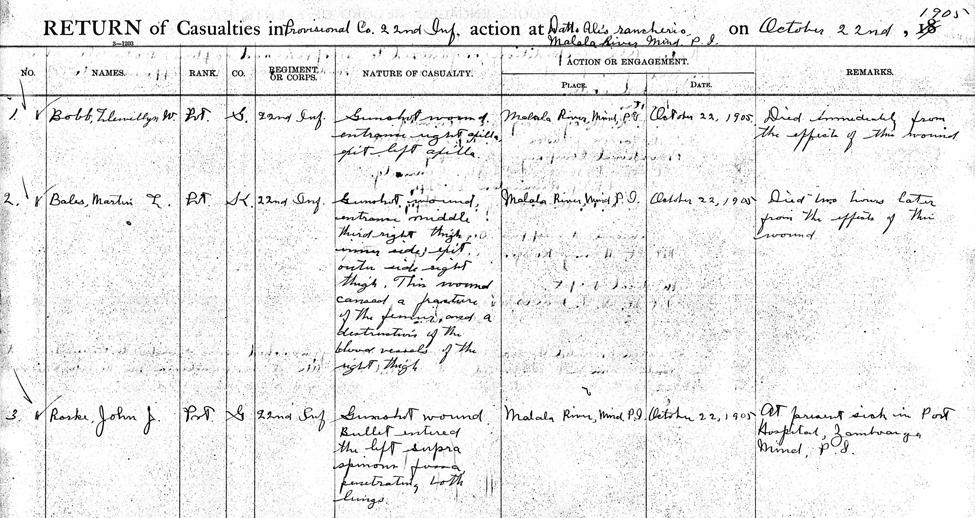
Above: The casualty report filed by Captain Frank McCoy
indicating the casualties of the Provisional Company of the 22nd
Infantry
in the fight at Datu Ali's rancheria.
Private John J. Rorke of Company G
listed on Line 3 in the above report was born in Lockport,
Niagara County, New York
in August 1882. He enlisted in the Army as a Private for a period
of 3 years on January 6, 1905 at Chicago, Illinois. His
enlistment
record indicated he stood 5 feet 5 ½ inches tall, had light
brown hair, blue eyes and a fair complexion. His previous
occupation was
listed as Laborer. He was assigned to and joined Company G 22nd
Infantry on March 10, 1905 at Camp Keithley on the Island of
Mindanao in the Philippines. The casualty report states that on
October 22, 1905 Private Rorke suffered a "Gunshot
wound. Bullet
entered the left supra spinous fossa penetrating both lungs."
He was admitted to the Post Hospital at Zamboanga on the Island
of
Mindanao. Rorke was discharged for disability in the line of duty
on July 20, 1906 while at the General Hospital at the Presidio
at San Francisco, California with a character reference of Good
and a notation of "service honest and
faithful." He was cited for
"bravery in action, in voluntarily
continuing in the fight after being severely wounded in both
lungs in engagement with Datu Ali"
in General Orders No. 43 Department of Mindanao December 31,
1905.
Private Martin L. Bales of Company K
listed on Line 2 in the above report was born in Annville,
Jackson County, Kentucky in January 1881.
He enlisted in the Army as a Private for a period of 3 years on
April 5, 1902 at Wichita, Kansas. His enlistment record indicated
he stood
5 feet 6 inches tall, had black hair, brown eyes and a ruddy
complexion. His previous occupation was listed as Farmer. Bales
served in
the 28th Field Artillery Company and was discharged from this
enlistment by General Order on December 15, 1904 at Fort
Leavenworth,
Kansas as a Private with a character reference of Excellent.
Bales re-enlisted in the Army on December 27, 1904 at Shawnee,
Oklahoma
Territory. On this enlistment his previous occupation was listed
as Soldier. He was assigned to and joined Company G 22nd Infantry
on March 10, 1905 at Camp Keithley on the Island of Mindanao in
the Philippines. The casualty report states that on October 22,
1905
Private Bales suffered a "Gunshot
wound, entrance middle third right thigh, inner side, exit outer
side right thigh. This wound caused a
fracture of the femur and a destruction of the blood vessels of
the right thigh." The report also
indicates that he "Died two hours later
from the effects of this wound."
|
Left: Private Llewellyn Winfield Bobb listed on Line 1 in the above report. Killed by Datu Ali on October
22, 1905 when Ali fired his rifle at Lieutenant Philip
Remington According to his enlistment
record Llewellyn W. Bobb was born in Richland County,
Wisconsin The casualty report states that
on October 22, 1905 Private Bobb suffered a "Gunshot
wound Private Bobb was buried in the
Post Cemetery at Camp Keithley and on July 14, 1906 his
remains Photo by orbweb49 from Ancestry.com |
This second provisional company of the regiment
acquitted itself as splendidly as had the first, accomplishing
its mission in the quickest time
and with the minimum loss of life, and unquestionably added
another lustrous page to the regiment's history. Following the
action
recommendations were submitted for the award of a certificate of
merit to Sergeant, First Class, J. C. Gunn, Hospital Corps;
Sergeant Louis A. Carr, Company K, Corporal Barry Smith, Company
G, and Private William B. Hutchinson, Company K, all of the 22nd
Infantry.
November 3, 1905, the provisional company
returned to Camp Keithley and was disbanded.
At this point the active service of the 22nd Infantry in the
Philippines came to an end; the regiment engaged in no further
field service,
and spent the following month in making extensive repairs to some
Spanish gunboats which had sunk, and in consequence had first to
be raised.
This in itself constituted an engineering project of considerable
proportions.
The 22nd Infantry left Manila for the United
States via Nagasaki on December 15, 1905, and arrived at San
Francisco,
January 14, 1906, after an uneventful voyage on the transport Sherman.
|
Captain Frank R. McCoy Personal Aide De Camp Photo taken 6 years after the Ali
expedition Left: A letter from Letter courtesy of Robert A. Fulton, MOROLAND The History of Uncle Sam Tumalo Creek Press, Bend, Oregon 2007, 2009 ISBN 978-0-9795173-0-3 |
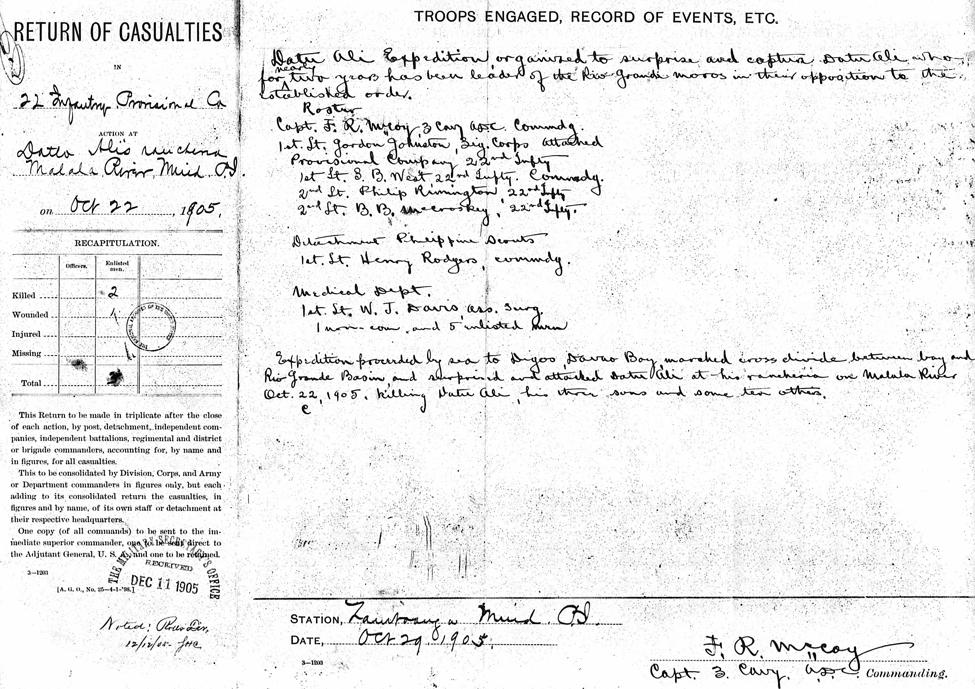
Above: The casualty report of the Datu Ali expedition filed by
Captain Frank McCoy giving a summary of the operation.
A week after Ali was killed the event made the US newspapers:
|
Left and above: article from |
|
Left and above: article from |
The following interesting
account of the Datu Ali expedition was published in the
Army And Navy Register January 6, 1906:
DEATH OF DATTO ALI
[The true story of the pursuit, capture and death of the notorious Moro outlaw told by a member of the 22d Infantry and published in the Philippines Gossip.]
Datto Ali, or rather "Datu
Ali," as he was known among his people, was a mere nobody a
few years ago. Being a great gambler, and a natural cutthroat,
he watched and waited for his opportunity to force himself
forward and become a leader of his people. The enactment of the
anti-slavery law in the
Moro province gave him the chance he was looking for. Gathering
about him the scum and riff-raft of the Cottabato Valley he
organized a gang of outlaws
and murderers, who caused the government considerable trouble and
annoyance until recently, when he met his death at the hands of
Lieutenant Philip Remington
of the 22d Infantry, while the latter was leading a charge
against the notorious outlaw.
Up to October General Wood had
made many attempts to locate and capture this robber chieftain.
He has had several scrimmages with the American troops,
but Invariably managed to elude capture and death.
When the anti-slavery law was
passed, Datu Ali seized upon it as an excellent means for
exciting the people, and many more Moros flocked to his standard,
believing him to be a "Heaven-sent leader."
The real causes leading to the
last and finally successful expedition against Datu Ali were
mainly the fact that the constabulary operating against him
were unable to successfully prevent his depredations, and a
letter was written under date of October 2, 1905, by Captain
George T. Langhorne,
11th cavalry, secretary of the Moro province and acting governor
during the temporary absence of General Leonard Wood, to
Brigadier General James A. Buchanan,
commanding the department of Mindanao, in which he said:
"Datto All has lately
commenced raidlng the friendly Moros on the Rio Grande,
Cottabato. It Is impossible for the constabulary force in control
of the province
to successfully prevent his depredations; therefore, I have the
honor to request that such steps as you may think necessary be
taken in order to capture
and destroy Ali and the band of desperadoes which follow
him."
Three days after the receipt of
this letter at the department headquarters. General Buchanan sent
the following Instructions to Major Crittenden,
then in command of the troops at Camp Kelthley:
"The department commander
is preparing an expedition to surprise and capture Datto Ali. In
view of the excellent service and experience of the 22d Infantry,
he has selected it to furnish the major part of the expedition
which will be commanded by Captain Frank R. McCoy, A. D. C., he
being
the only officer in the department who has been over the route
decided on.
"He directs that for this
hard and important work one first lieutenant, two second
lieutenants and one hundred picked men be selected, as were those
forming
the original provisional company, armed and equipped as at the
end of their tour in the Rio Grande Valley, and be prepared to
board the 'Sabah' at
Camp Overton on the morning of the 13th instant.
"The necessary medical
attendance and supplies will be furnished. One hundred rounds
extra rifle ammunition and forty rounds extra revolver ammunition
will be taken per man.
"The destination of these troops further than Camp Overton will not be made known to even the officers with them."
At the same time General
Buchanan wired the commanding officer of the troops at Camp
Overton to make every arrangement for rations, supplies, etc.,
so as not to delay the troops.
Other than the general himself,
Major Crittenden and Captain McCoy, there was not a soul, either
among the troops or the Moros who had the faintest idea
of what the expedition was for. Even Datu Ali considered himself
safe, as word was always brought him by swift runners of every
expedition against him.
All plans, arrangements, etc.,
for the capture of All were placed in the hands of Captain Frank
R. McCoy, a youthful but able officer, aide-de-camp
to Major General Leonard Wood. He was given full power and
selected his forces with the greatest care. He had with him 1st
Lieutenant Gordon Johnson,
signal corps, as field quartermaster and commissary; 1st
Lieutenant Wilson T. Davis, assistant surgeon, as the surgeon, a
young medical officer who
has made an enviable record for himself at Corregidor Island,
while in charge of the tuberculosis ward; arid a provisional
company of the 22d Infantry,
consisting of 1st Lieutenant S. B. West, and 2d Lieutenants
Philip Remington and B. B. McCroskey; a detachment of the
Philippine scouts under
1st Lieutenant Henry Rodgers, several hospital corps men, one
interpreter, Datto Enok, as guide, Stevedore Clement and 186
cargadores.
Captain McCoy realized that for
the past two years several unsuccessful attempts had been made to
capture Datu Ali, and knew that if he attempted
to go by way of the Cottabato Valley he could not succeed, as
every movement of troops in that region was at once made known to
him by spies.
Datu Ali's hiding place was
supposed to be somewhere in the Lake Liguasan region. Captain
McCoy knew of but one trail by which he might reach the
Moro outlaw, and that was the trail from Digos, on the Gulf of
Davao, through the Bagobo and Bilan country, to Buluan. As there
were no Moros living
on that trail and as the Hill men in that region were more afraid
of Ali than of the Americans, the department commander thought
that trail the only medium
through which to affect a surprise.
The department commander,
General Buchanan, conferred with Captain McCoy and enjoined the
strictest kind of secrecy in all that pertained to this
expedition,
as the sole hope of capturing Ali was through his (Ali's)
ignorance of the move.
Therefore, at the suggestion of
General Buchanan, Captain McCoy, at that time acting as chief
quartermaster of the department, openly proceeded to the
Cottabato Valley, apparently in his capacity as chief
quartermaster, and excited no suspicion among the Moros. While in
the Cottabato Valley he obtained
some very valuable information, which, unlike the information
usually obtained from the Moros, was accurate and correct.
Datto Piang, the Sheriff Afdal
and Datto Enok, all friendly to the Americans, divulged the
information that owing to sickness in the family of Datu Ali,
the Moro chief had left his hiding place in the Lake Liguasan
country and had settled with a personal body-guard at his
rancheria, which was reported
to be located somewhere (vague, but we made it do) on the Malala
River.
Accordingly, the one hundred
picked men and the three officers of the 22d infantry left Camp
Keithley on October 11 and boarded the chartered transport
Sabah making for Zamboanga, where they arrived the following
night, picking up Captain McCoy, Lieutenant Davis, the surgeon
and Lieutenant Johnson,
when the entire expedition proceeded to Digos on the Gulf of
Davao.
About the same time the
chartered transport Borneo sailed from Zamboanga for Digos via
Margosatubig, with the cargadores and to pick up
Lieutenant Henry Rodgers with his detachment of Philippine
scouts, the entire party there to concentrate and move out
against the Moro outlaw.
On the 19th of the month the
department commander ordered two companies of the 19th infantry
from Malabang and one company from Parang to
Cabacsalan Island, Captain John Howard commanding the troops of
the 19th Infantry.
The expedition landed at Digos, on Davao Bay, on the afternoon of October 16 and disembarked from the Sabah and Borneo.
While there, they secured the
services of Lieutenant E. C. Bolton, 17th Infantry, governor of
Davao, and Mr. Skinner, an American planter, to accompany them.
The fact of Lieutenant Bolton and the American planter
accompanying the expedition, allayed the fear of the hill tribes
and kept them from deserting their villages
and spreading the news of the expedition.
When the expedition reached the
divide between Davao Bay and the Rio Grande Basin it was decided
that only the ablest men were to proceed on further.
So Lieutenant Rodgers with the scouts, all the cargdaores and
supplies, and all men who had sore feet, who were played out,
etc., were left behind
to follow at their leisure, while the seventy-seven healthy
remaining members of the provisional company were to make a dash
for Datu Ali's rancheria,
stripped of all impedimentia, excepting one day's cooked rations,
and last, but far from least, reserve ammunition.
For the next two days this
little band steadily marched through an extremely hostile
country, over mountains and swamps, crossing swollen streams and
crawling through jungles, by night as well as by day, living on
what snatches of food, such as hardtack and canned salmon, they
had time to bite, and just at
daybreak on the morning of October 22 they approached Datto Ali's
rancheria on the Malala river, after a forced and rapid march of
over 50 miles
over an almost impassable country.
Lieutenant Philip Remington, 22d
infantry, was placed in charge of the advance guard; Captain
McCoy commanded the main body, while Lieutenants
West and Johnson each commanded a detachment that was advancing
on Ali's rancheria from both right and left, so that there was
practically no escape for him.
When within about three hundred
yards of Ali's house, a party of eight Moros armed with spears
and krises was surprised and captured by Captain McCoy,
just as Lieutenant Remington with the advance guard had reached
the clearing around Datu Ali's house.
Seeing Datu Ali and some twelve
armed men sitting on the porch of the house, Lieutenant Remington
with two squads gave the command "Charge!"
and all dashed forward hoping to capture the un-armed party, but
quick as Lieutenant Remington was, wily old Ali was still
quicker,
for in a second's time they all jumped back into the house and
Datu Ali remaining alone on the porch raised his rifle and fired
pointblank,
killing Private Llewellyn W. Bobb, company G, 22d Infantry.
Almost at the same instant Lieutenant Remington raised his revolver and fired, shooting Datu Ali through the body and bringing him to his knees.
Under the cover of a galling fire from his followers he struggled to his feet and endeavored to escape, but was riddled by the remainder of the advance guard.
Datu Ali's followers enraged at
the death of their chief kept up a stirring fire from the
interior of the house, wounding two more of the advance guard.
In the meantime, Lieutenants West and Johnson had cut their way
through the heavy foliage and underbrush on right and left and
advanced on the
double quick, firing rapidly and cutting off all escape.
Captain McCoy then united with Lieutenant Remington and the advance guard.
When Datto Enok excitedly yelled
the all important news, "Datu Ala Muerte," all firing
ceased and recall was immediately sounded. The wounded Moros
were turned over to the tender mercies of Datto Enok, and all the
surrounding houses searched for arms, ammunition and other
munitions of war.
Word was then sent by messengers to all the surrounding rancherias that they had no more to fear.
Datu Ali, the terror of the
valley, was dead, and hostile operations in the Rio Grande valley
were all over. Private Martin L. Bales company K, 22d Infantry,
who was wounded, died within an hour afterward, while Private
John J. Rorke, company G, 22d Infantry, while wounded through the
lungs seemed to do well
and took part in the remainder of the engagement. Shortly
afterward the camp was removed to the Alip river, where
Lieutenant Rodgers with his scouts,
train, supplies, exhausted men, etc., rejoined and the entire
command proceeded on the following day to Buluan, to await the
arrival of vintas and rations
by way of Lake Liguasan.
On the 26th Instant, Captain
Howard, with the 19th infantry, arrived with vintas and rations
when the expedition proceeded to Cabacsalan Island,
where it reported to the commanding general of the department, on
the evening of the 28th and there was disbanded.
Captain McCoy, in speaking of
the conduct of the officers and men on this expedition, says that
it was of the highest order, and recommends for
certificates of merit, 1st Class Sergeant James C. Gunn, hospital
corps (twice wounded in the attack on Peruka Utig's Cotta in May,
1904,)
for particularly meritorious and excellent services throughout
the expedition in caring for the wounded while under a heavy fire
in the attack on Datu Ali.
He also recommends Corporal Barry Smith, company G, 22d Infantry,
the non-commlssloned officer in charge of the advance guard, for
special bravery
in action; Private William R. Hutchinson, company K, 22d
infantry, member of the advance guard, for bravery in action and
fine marksmanship;
Sergeant Lewis A. Carr, company K, 22d infantry, for arduous work
and rare judgment as quartermaster sergeant, in charge of all
supplies and cargadores.
Sergeant Carr often worked day and night and the peculiar
conditions attending the expedition made the care and
distribution of the six days' rations,
which had to last for ten days, a matter of rare importance.
In his report of the expedition,
the department commander takes advantage of his opportunity to
thank Major John J. Crittenden, commanding the 22d infantry,
for the admirable manner in which he carried out his orders and
instructions. He also speaks of the fact that Datto Ali had
terrorized the Cottabato Valley
for months, killing Moros friendly to Americans and threatening
the lives of others. Complaints were made by the hill tribes
living around Simpetan
and the Gulf of Davao that he had looted their villages and
carried off their woman.
The department commander has
called the attention of the division commander to the great
hardships experienced by Captain McCoy
and his command in their march through a country specially
adopted for four-footed animals or winged travellers.
Attention is finally invited to the superb discipline of the
officers and enlisted men of the 22d infantry.
In 1936 the Chicago Tribune
newspaper printed a two page article commemorating the Datu Ali
expedition
as part of the paper's "Making America" series. The
article featured a stylized but detailed map
and also included photos of Frank R. McCoy as a Major General in
1936 and as a young Lieutenant
in the 10th cavalry:
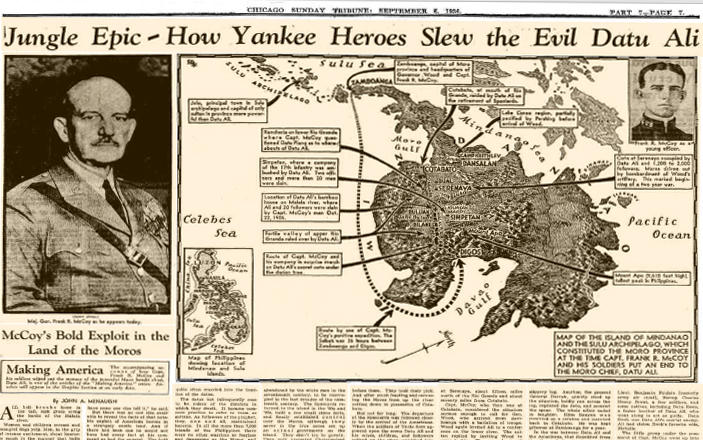
Above: The top section of the first page of the article in the Chicago Tribune Sunday September 6, 1936
From the Chicago Tribune website
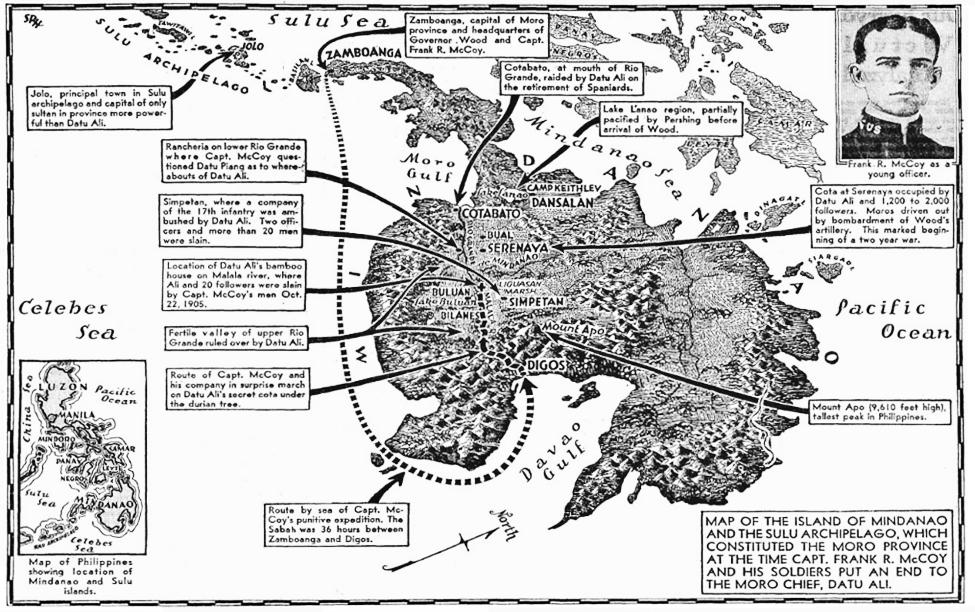
Above: The map from the 1936 Chicago Tribune article
From the Chicago Tribune website
Below is the text of the article
from the Chicago Tribune of September 6, 1936. As in the above
articles about the
Datu Ali expedition, this article gives additional details and
information:
Jungle Epic - How Yankee Heroes
Slew the Evil Datu Ali
McCoy's Bold Exploit in the Land of the
Moros
Making America
The accompanying account of how Capt. Frank R. McCoy and his
soldiers wiped out the menace of the powerful Moro bandit chief,
Datu Ali,
is one of the articles of the " Making America "
series. Another will appear in the Graphic Section at an early
date.
By JOHN A. MENAUGH
ALL hell breaks loose in the tall, lush grass along the banks of
the Malala river.
Women and children scream and mongrel dogs yelp. Men, in the grip
of intense excitement, shout hoarsely much in the manner that
bulls bellow. Rifles roar
on every hand, and the din is punctuated by the deep coughs of
heavy revolvers. The air is laden with the penetrating fumes of
smokeless powder.
Death holds carnival on the Malala.
From a barricaded bamboo house under a solitary durian tree come
flashes of fire as weapons of various sorts are exploded toward
the thin ring of khaki-clad soldiers
circling the habitat. The flashes of flame are answered by others
from the circle. The soldiers swiftly close in.
A gigantic man, his gleaming body bare except for a scanty
breechclout, emerges from the low door of the house. In his hands
is a Mauser rifle,
the bolt of which he works furiously as he delivers a stream of
metal jacketed bullets toward the line of soldiers before the
door of the house.
A revolver and twelve rifles--- these are Springfields---speak
simultaneously. The huge man with the Mauser sinks to the ground.
His figure is motionless.
Datu Ali, raider, robber, and woman stealer, is dead.
How Capt. Frank R. McCoy, a young American cavalry officer, more
than thirty years ago put a fatal finish to the depredations of
the powerfully dangerous
Moro chieftain, Datu All, and brought peace to the valley of the
Rio Grande de Mindanao in the Philippine Islands, is a story that
involves:
A company of fearless, fighting Americanos, struggling and
sweating through the Filipino jungles as only heroes can.
Assorted Moros, some hostile, some friendly.
A lonely durian tree, which turned out to be the key to the
success of an avenging expedition.
And a lot of background and foreword that are essential to the
proper unfolding of the story.
McCoy, who since 1929 has been a major general, who saw active
service in France in the World war, and who has been almost
everywhere on strange,
surprising, and highly important missions, would tell you that
the destruction of Datu All was wholly, or almost wholly, due to
luck. He is prone to minimize
his part in the affair. Yet, Without the initiative of young
Capt. McCoy it is doubtful that Datu All, Public Enemy No. 1 of
the Island of Mindanao,
could have been trailed to his doom on the banks of the Malala,
Oct. 22,1905.
"When you write this," said Gen. McCoy not long ago,
" do not make it appear that I am telling the story. First
person pronouns seem a bit too much like boasting.
Just let me tell it all to you as I remember it, and then you
retell it in your own words."
It is true indeed that the general was reluctant to provide the
account of the fateful expedition against Datu All. " Much
better to have some one else tell it," he said.
But there was no one else available to reveal the facts of that
notable exploit of American heroes in a strangely exotic land.
And if there had been one
he would not have had every fact at his command as had the
general. The bold action that brought lasting peace to the valley
of the Rio Grande
was history of the brand that helped make America.
Fire kindled in McCoy's kindly eyes as he relived again the
stirring days spent in the quest of the jungle scourge, Datu Ali.
The story begins properly 415 years ago, when Spaniards first set
foot on the southern islands of what now are known as the
Philippines.
Those first daring explorers found on the islands a native
people, bronze hued and rather small of stature, but quick and
cunning and far more
intelligent than ordinary savage islanders. Because these people
were Mohammedans and of dark complexion, the Spaniards called
them Moros,
the identical Spanish word for another people, the Moors, dusky
Mohammedans with whom the Spaniards had been battling for
centuries
back on the other side of the world.
Ancestors of these Moros had come into the Philippines from
Malaysia in the dim and distant past. They had brought the faith
of Islam with them,
had interbred with other peoples already on the islands, and had
produced a race of upstanding, fearless men and women who asked
no privileges,
who took what they wanted and what they needed. They had their
own nobility, their noblemen generally possessing in their veins
true Arabic blood.
Each nobleman, or datu, had as headman in his household a tall
dignified Arab. These Arabs quite often married into the families
of the datus.
The datus not infrequently rose to be rulers of the districts in
which they dwelt. It became common practice to refer to them as
sultans.
As followers of the prophet, they, one and all, maintained
harems. In all the more than 7,000 islands of the Philippines
there were no other warriors
so fearless and dangerous as the Moros, and no Moros so difficult
to combat as their noblemen, the datus.
Favorite arm of the Moros was the kris, or creese, a wicked,
swordlike cutting weapon. Some of these were straight bladed,
others had wavy edges.
Each tribe was partial to its own particular kind of kris. Datu
Ali, villain of the chapter of history that has to do with
Mindanao in the early 1900s,
was equally proficient with straight bladed and wavy edged kris.
The barong and the campilan were variants of the kris. Moros also
used spears
in warfare and in hunting, but apparently never mastered the bow
and arrow. They took to firearms after the arrival of Europeans,
learned to make
crude muskets and cannon, solved the mystery of the manufacture
of gunpowder, and grew skilful at stealing rifles from the white
men.
The Spaniards who established settlements in the Philippines were
able to Christianize many of the tribes, especially those of the
northerly islands,
but they never made much headway in missionary work among the
Moros. The last named remained throughout the Spanish occupation
more fiercely Mohammedan than Arab or Turk. Though now pacified,
they still adhere to the faith of their ancestors.
Spain made little pretense at attempting to civilize the natives
of Mindanao, the area of which is slightly greater than that of
the state of Indiana.
A few feeble efforts met with failure in the early days, and the
Island was virtually abandoned by the white men in the
seventeenth century,
to be reoccupied in the last decades of the nineteenth century.
The Spaniards returned to the island in the '80s and '90s, built
a few small stone forts,
and finally established control over the Moros, although they
never in the true sense set up an actual government on the
island. They didn't try to govern.
They only protected Christianized Filipinos, Chinese, and others.
It was Gen. Valeriano Weyler y Nicolau, marques of Tenerife,
better known as
"The Butcher" of the Cuban war, who temporarily
pacified the Moros, who whipped their chieftain, an uncle of Datu
Ali, and made the territory in the
neighborhood of Spanish forts relatively safe for Spaniards.
Then came the Spanish-American war in 1898. The defeated
Spaniards moved out of Mindanao in 1901.
After the evacuation of the Spanish garrisons and before the
arrival of American troops in the remote island there flashed
into the picture the then
little known sultan of the upper valley of the Rio Grande de
Mindanao, a great sprawling fertile lowland, crossed by streams,
dotted here and there with rice fields,
and hemmed in on all sides by mountains, at the bases of which
were thick, tropical jungles. This sultan's name was Datu Ali. He
was a strapping fellow
well over 6 feet in height. He and his brother, Djim Bangan, also
a giant of a man, although lacking some of the fiercely warlike
qualities of Ali, moved down
the Rio Grande with their followers and raided the town of
Cotabato [cota means fort; bato means stone; cotabato means
stonefort], which had been
left to their mercy by the Spaniards. Native homes were looted.
The blade of the kris flashed in the sunlight. The earth grew
damp with a deep red stain.
It was much like the sacking of an ancient town by buccaneers,
and almost as bloody. Datu Ali and Djim Bangan ordered all the
women, of the village
paraded before them. They took their pick. And after much
feasting and carousing the Moros from up the river settled down
in possession of Cotabato.
But not for long. The departure of the Spaniards was followed
closely by the arrival of the Americans. When the soldiers of
Uncle Sam appeared upon the scene
Datu Ali and his wives, children, and followers retired up the
river---vanished into the wilds of the upper valley.
The first American commander in that region was Col. Lea Febiger.
As Capt. John Pershing [the general of World war fame] was
pacifying to a degree
the Moros of the Lake L'anao district. to the north of Cotabato,
Col. Febiger was winning the friendship of Datu Ali, sultan of
the upper valley
of the Rio Grande. The Louisiana Purchase exposition was
scheduled to be held in St. Louis in 1903 [it was delayed a
year], and Febiger suggested
that Ali and his wives be included in the group of Filipinos who
were to be taken to the fair. All arrangements had been made to
transport the sultan
and his harem to the United States when some enterprising
American discovered that the Moros were slaveowners and that some
of the native individuals
slated for a trip to St. Louis actually were slaves. Washington
called off Ali's excursion at the last moment.
That was an affront that Datu Alt could not ignore. Moro chiefs
refuse to be treated shabbily, even by governments. And Ali was
more sensitive than
most noble Moros. He had lost face among his people. He broke off
friendly relations with Americans. He was through.
In 1903 Leonard Wood, just promoted to major general, was ordered
to the Philippines, his assignment being to organize a government
in the Moro province
to supplant the mere army post control then in existence. The
province took in all of the Island of Mindanao, except certain
Christian districts, and the
Sulu archipelago, the last named territory ruled over by the only
sultan in the Philippines more powerful than Datu Ali. The
capital of the Moro province was Zamboanga.
Accompanying Gen. Wood to the new American possessions, over
which years later he was to become governor general, was Capt.
McCoy. The young officer
was the general's aid. He was appointed to the council of five
which constituted the executive body handling the affairs of the
new government. This council
ordered roads built, established district governors, and in
general created order out of chaos. There were two army officers
on the council of five,
and three civilians. These men and their subordinates worked
directly through native chiefs.
Gen. Wood realized that if he could bring Datu Ali, most powerful
sultan in Mindanao, to terms he would be going a great way toward
establishing permanent peace.
The general sent word to Ali, inviting the sultan to become
headman of the upper valley as the representative of the American
government. Ali replied that he
would not act under American orders. Hostilities began when Ali
retired to a cota at Serenaya, about fifteen miles north of the
Rio Grande
and about seventy miles from Cotabato.
Capt. McCoy, who then was at Cotabato, considered the situation
serious enough to call for Gen. Wood, who arrived from Zamboanga
with a battalion of troops.
Wood again invited Ali to a conference on the lower river. The
sultan replied by inviting Wood to come to him. The general set
out with his troops for Serenaya.
On the way the Americans were ambushed. A few were wounded. Ali
fell back to the fort at Serenaya, which consisted of a series of
earthworks with bastions,
the whole revetted with bamboo. When Capt. McCoy inspected it
after its capture he found it to be the strongest native fort he
had ever seen.
Wood sent back to Cotabato for artillery. The guns were dragged
through rice fields and jungles to the vicinity of the cota at
Serenaya, where All,
with 1,200 to 2,000 followers, was taking refuge behind the
protection of some sixty native bronze cannon and twenty old
Spanish pieces,
some of large caliber. Gen. Wood turned his gunners loose on the
Moro fort. Shells ripped through jungle foliage. Splinters and
flying earth filled the air.
Surviving Moros stole out of the fort and vanished, leaving
several hundred dead and wounded behind. It was the start of a
two year war.
After the bombardment at Serenaya Ali fled to Bual, pursued by
the American troops. Capt. McCoy went along with the soldiers as
an interpreter,
and it was on this expedition that Djim Banyan, Ali's brother,
was captured under highly amusing circumstances. The big Moro
fled across a wet log
spanning a stream, and stood at bay with an uplifted spear. One
of the American officers fell into the stream in trying to
negotiate the slippery log.
Another, the present General Darrah, quickly sized up the
situation, boldly ran across the log, captured the datu, and
secured the spear.
The whole affair ended in laughter. Djim Banyan was mounted on a
carabao and marched back to Cotabato. He was kept prisoner at
Zamboanga for a year.
In the war between Datu Ali and the Americans that flourished
from the time of the bombardment at Serenaya to the death of the
Moro sultan,
Ali had all the best of it. His espionage was better than that of
the Americans. Peaceful natives were afraid to betray him, for
his vengeance was
far-reaching. He raided up and down and across and back the wide
valley of the Rio Grande. He even went beyond the limits of his
own territory.
He looted villages, put to death those who opposed him, and stole
all the pretty girls upon whom his eyes fell. His warriors
ambushed American
detachments in the jungles, fired their stolen rifles at the
white men who saw nothing to shoot at in the black shadows of the
trees, and laughed as they fled
before the wrath that was next to helpless in a disadvantage such
as that.
In one of these ambushes planted by Datu Ali two officers and
more than twenty men were slain. It was a company of the 17th
infantry, under two young lieutenants,
Woodruff and Hall, that marched into the death trap at a place
called Simpetan, on the edge of the Liguasan marsh, far up in the
valley of the Rio Grande.
Only twelve of the company survived. The Moros captured between
thirty and forty Springfield rifles.
Troops were dispatched up the river to the scene of the ambush.
There was nothing that could be done, however. On the return from
Simpetan Capt. McCoy
was left at Buluan with orders to go up into the hills and warn
peaceful natives against Datu Ali. With McCoy were Lieut.
Benjamin Foulois [recently army air chief],
Bishop Charles Henry Brent, a few soldiers, and some natives,
including Datu Enok, a foster brother of Datu Ali, who went along
to act as guide. Datu Enok
was Datu Ali's mortal enemy. Ali had stolen Enok's favorite wife,
Makalie.
The little group under the command of Capt. McCoy went up into
the jungle country south of Mount Apo, the highest peak in the
Philippines.
McCoy and Foulois were the first American officers ever to
penetrate this isolated region. They came out at a place called
Digos, on Davao gulf.
On the evening after separating from the main force at Buluan the
little party camped on the Malala river. While the natives were
making camp
for the soldiers, Datu Enok and Capt. McCoy stood together gazing
at the colorful panorama before them. The guide pointed out the
peak of
Mount Apo, then called attention to a great pyramidal tree to the
northeast that reared itself above the surrounding landscape.
Between the two men
and the tree was only flat territory, covered with tall grass.
"That's a durian tree," said Datu Enok. " It is
the only one within a hundred miles. Natives come here from over
the whole valley to eat of its fruit."
The tree of this species bears a spherical fruit six to eight
inches in diameter. The inside of the fruit when ripe has the
consistency of custard and,
although it smells to the heavens, the natives like it.
The lone durian tree on the banks of the Malala turned out to be
more than just an attraction to hungry Moros. How it proved the
key
to the collapse of Moro resistance in Mindanao will be revealed
as the story unfolds.
Datu Ali's defiance of American authority dragged on through the
months. Gen. Wood was making ready to return to the United States
on leave,
but before he departed he made another effort to arrange a truce
with the wily Moro sultan. He sent the other of his two aids,
Capt. Ralstead Dorey
and a Syrian doctor, Najab Saleeby, who spoke Arabic, up the Rio
Grande to the rancheria of one Datu Piang, a cunning old
chieftain,
part Moro and part Chinese. Capt. Dorey there conferred with Datu
Ali, who finally agreed to come to terms and yield to the
Americans.
A proposed surrender of arms on the part of the Moro sultan
proved a stumbling block to the proceedings. After three or four
days of parley
Ali vanished in the night. He had been fooling all the while.
And when he disappeared he took with him Datu Piang's favorite
daughter, Minka.
Gen. Wood went away, leaving Capt. McCoy as acting governor. It
was decided to do nothing about Datu Ali until Wood's return,
the plan being to keep negotiations with the elusive Moro alive
until the general could be present to direct them.
The program was changed, however, just before the expected return
of Wood. Brig. Gen. James A. Buchanan had been sent in to assume
command
of the troops in Mindanao, although not to supplant Wood as
governor. McCoy had been relieved of the duties of acting
governor, but still
was a member of the legislative council. The new plan was to make
one more try for Datu Ali.
Capt. McCoy went up the river to Datu Piang's place to see if he
could learn from the old man, whom he knew as " a clever old
coon," the whereabouts
of the slippery Datu Ali. Datu Piang was friendly to the
Americans. But he also was friendly to, or fearful of, Datu All.
For several days McCoy remained
at Piang's rancheria, making no headway at worming the secret of
Ali's whereabouts out of his host. Finally, realizing that he was
getting nowhere
and time was flying, McCoy put the case squarely up to Piang in
words like these:
"Now, Piang, I'm going back, and you haven't told me
anything. I don't want to have to tell Gen. Wood that you have
told me nothing.
I know you know where Ali is."
Piang did not relish the role of enemy to Gen. Wood. He slowly
revealed to Capt. McCoy that he knew where Ali was hiding out.
Six weeks before,
according to Piang, Ali had sent for Minka's mother to nurse
Minka through a spell of sickness. The old woman had been taken
up the river,
through the marsh, or everglades, to the Malala river. She had
returned to Piang's place the day before the arrival of McCoy.
Piang felt that he could tell Capt. McCoy where Ali was
hiding---that is, in a rather indefinite way. He knew that the
soldiers could not go up the Rio Grande
without Ali being informed of their approach. And he also knew
that in telling McCoy that Ali was camped on the Malala he was
not revealing the location
with any great degree of accuracy. There were thousands of places
to hide along the stretches of the winding river.
The old native told the captain that Ali was staying in a house
on high ground somewhere [he wasn't certain just where] on the
banks of the Malala.
Without giving the matter a thought, Piang said that the house
stood under a durian tree.
That was enough for Capt. McCoy.
Back to Zamboanga went McCoy immediately. Gen. . Buchanan was for
dispatching an expedition at once, to capture or kill Datu Ali.
McCoy suggested
a secret expedition, by way of Davao gulf and an overland march
to the Malala river from the east. From Digos, where the
expedition finally landed,
to within fifteen miles of the house in which Datu Ali was found,
was the rankest kind of jungle. The route was over a divide, and
along the bases
of the mountains. McCoy knew that any expedition approaching the
Malala river from Cotabato could have no secrecy---that Datu Ali
would know about it
days in advance of its arrival. The captain also knew that by
going in the back door, so to speak, he would have a chance to
trap the foxy chief.
Gen. Buchanan insisted that McCoy lead the troops against the
Moro sultan.
The, captain therefore chose a company of the 22d infantry, which
was stationed at Camp Keithley on Lake L'anao. He wanted soldiers
from the camp
most remote from the valley of the Rio Grande. He didn't want his
plans to leak out. The soldiers were taken to Zamboanga , with it
understood
that they were going on an expedition to the Sulu Islands.
There were a hundred soldiers and a company of native scouts
under Capt. Henry Rodgers in the little force selected to go
after Datu All. Capt. McCoy
took Lieut. Gordon Johnston [the Col. Johnston killed in a polo
accident in Texas in 1934] as his right hand man. Also on the
expedition were
Lieut. Philip Remington, Lieut. Solomon B. West, Lieut. B. M.
McCroskey, Dr. W. T. Davis, 150 native bearers, Datu Enok, the
sworn enemy of Datu Ali,
and Tomas Torres, a Filipino veteran of Moro wars, whose wife
also had been stolen by Ali. Torres knew Ali by sight.
The expedition sailed from Zamboanga in the little steamer Sabah.
A landing was made at Digos in Davao gulf. McCoy's plan was to
push forward as rapidly
as possible in order to reach the house under the durian tree
before Datu Ali could learn of his advance. The soldiers and
native scouts and bearers
plunged into the jungle, working their way up to the divide near
Mount Apo. The whole advance toward the goal on the Malala river
took six days,
the soldiers, however, marching in the main by night. When the
divide was reached it was found that twenty-three of the soldiers
were played out.
Others of the expedition pushed on toward Ali's hiding place.
Capt. McCoy had in his mind as a possible danger point the
village of Bilanes on the route to Ali's house. He expected to
make a forced march
from the divide by day, then halt for a while, and work around
the village at night. Instead, he miscalculated and blundered
into the village.
It was dark when this happened, and rain was falling. McCoy's
soldiers rushed through the village to the barking of dogs and
the beating of gongs,
and soon were between it and Ali. In the meantime five more men
had been overcome by fatigue. They were left behind, somewhere
near the village of Bilanes.
After stumbling into the little native settlement the troops
rested from 7 o'clock until midnight. McCoy and Johnson made a
reconnaissance as the soldiers slept.
At daylight the advancing column came to the banks of the Malala
river. Two Moros were on the other side, one astride a pony, the
other afoot. Lieut. Johnston
was about to fire his revolver at them when he was restrained by
Capt. McCoy. The captain did not want to give the alarm, and he
was not certain that
the two Moros were messengers sent from the village of the
Bilanes to warn Ali of the approach of the Americans. As it
transpired, however, that is exactly
the mission that the two were on. They rushed to Ali and told him
the soldiers were near, but All refused to believe them until it
was too late. The villagers
had not seen the soldiers as they ran through in the dark. They
had only surmised that the party rushing through was made up of
Americans.
That was why Ali was skeptical.
The Americans and the few scouts accompanying them advanced
rapidly in the early gray of the morning, crossing and recrossing
the river several times
until they came to the ford nearest the house under the durian
tree. A guard of seven men who had been watching this crossing
had departed
for breakfast shortly before the weary American soldiers arrived
at 6 o clock. That was one of the circumstances that McCoy
considered sheer luck.
Lieut. Remington was ordered to go forward as speedily as
possible with seventeen picked men---his job to capture or kill
Datu Ali before the Moros
could organize resistance. Remington and his men advanced at a
dog trot through the tall grass. Lieut. Johnston with a platoon
moved to the left
to cover the river. Lieut. West and others of the soldiers
proceeded to the right to keep any of the enemy from fleeing on
that side by the way of the river.
Above the waving grass Capt. McCoy saw the spears of the seven
Moro guards returning to the ford after having had their coffee.
These guards
had missed Remington and his soldiers. McCoy indicated to the men
with him that he to lake the seven without sounding an alarm, and
just as his soldiers
pounced upon the natives there came from the vicinity of the
bamboo hideout of Datu Ali the sound of gunfire.
When the shooting began at the house McCoy ran ahead to join
Remington. As he broke out of the taIl grass about a hundred
yards from the house
he saw a line of his soldiers firing into the bamboo structure.
He saw both Datu Enolk and Tomas Torres firing toward the house.
He saw Remington
firing with a .45 caliber revolver. The expedition had armed
itself at Zamboanga with pistols heavier than the then regulation
.32 caliber service weapons,
in the knowledge that Moros required a weight of lead to stop
them.
McCoy saw a gigantic Moro emerge from the door of the house. The
man was without sarong or turban---nude except for a small
breechclout.
In his hands he held a rifle---a Mauser, a weapon of a make
popularized among the Moros by the Spaniards. The big Moro was
shooting fast.
One of his bullets killed a man standing near Remington.
Remington fired his revolver at the man with the Mauser. At the
same time a dozen other American soldiers let loose their
Springfields at the man.
Every bullet hit him. He fell.
"That was Ali," shouted Tomas Torres.
McCoy called to Remington to cease firing. Johnston, on the bank
of the river, had heard the name of Ali shouted above the din of
battle.
He saw a Moro make for the river and thought it was Datu Ali
escaping. The lieutenant jumped into the river himself, and
almost drowned,
but the fleeing Moro got away, the only one to escape from the
great bamboo house that stood only sixty feet from the bank of
the Malala under the durian tree.
As Remington emerged from the cover of the tall grass he bad seen
a group of Moros taking coffee on a platform in front of the
house. He rushed at them,
firing as he ran. The Moros retreated into the house, lay down on
the floor, and fired through loopholes with Springfields and
Mausers at the soldiers on the outside.
There were twenty-one Moro men in all in the house, and in
addition were the wives and some of the children of Datu Ali.
Only Ali of all the Moros stood up
to fight it out with his enemies.
Datu Enok called to those in the house to surrender. A woman's
voice answered that all of the men had been killed. In the place
were twenty women
and children, nearly all of whom had been wounded. But no woman
or child was slain.
Dr. Davis attended to the wounds of the women and children, as
well as those of the Americans who had received bullets in the
fight. Two Americans
were killed, and three wounded. Minka, the daughter of Datu
Piang, at first would not allow the doctor to dress her wounds.
As Capt. McCoy talked to her,
urging her to accept the physician's care, he turned toward the
house and beheld an amazing sight.
A woman, stark naked, was coming out of the house. In her arms
she held a baby. The woman was badly wounded. She was Datu Enok's
stolen wife, Makalie.
Finally all the wounds were dressed, including those of Minka.
The dead were buried, and the women and children collected
together and sent down the river.
The soldiers recovered the rifles taken in the ambush at
Simpetan. Datu Enok, at his own request, got back his wife. The
troops moved to Buluan on Lake Buluan,
where they took up a defensive position and waited for other
troops sent in from Cotabato by Gen. Buchanan.
Then Capt. McCoy and his soldiers went down the river, through
the sunbathed valley of the Rio Grande, in which no hostile shot
has been fired
since that eventful day of Oct. 22, 1905.
"What was Datu Ali wearing when he was killed?" Datu
Piang asked Capt. McCoy weeks later.
"Only a breechclout," rejoined the captain.
"Didn't he have on a shirt? " queried the old man.
"No," said McCoy.
"That's why he was killed. He wasn't Wearing his magic
shirt," confided Piang.
It seems that All, as an alleged descendant of Mohammed.
possessed a bulletproof shirt of silk, and a pot of sacred oil
that was guaranteed to keep him safe from harm.
But no charms were working at that fateful hour when he stopped
more than a dozen bullets on the banks of the Malala.
Article from the Chicago Tribune Sunday September 6, 1936
From the Chicago Tribune website
Incredibly, within a few months,
a report originating in Manila, that Ali was not killed,
but was still alive on Mindanao, appeared in US newspapers:
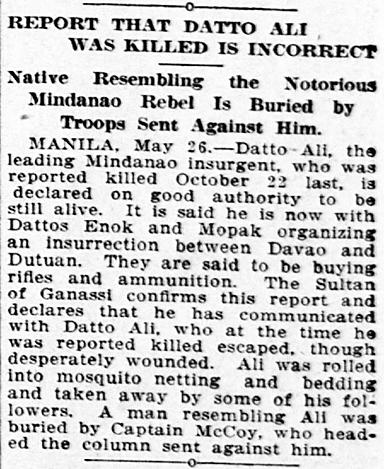
From the San Francisco Call, Saturday, May 26, 1906
CDNC California Digital Newspaper Collection
Within two days articles were
published
to contradict the report that Ali was still alive:
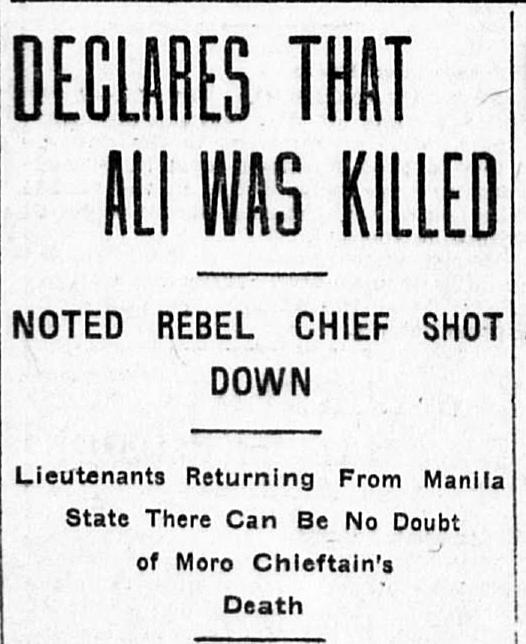
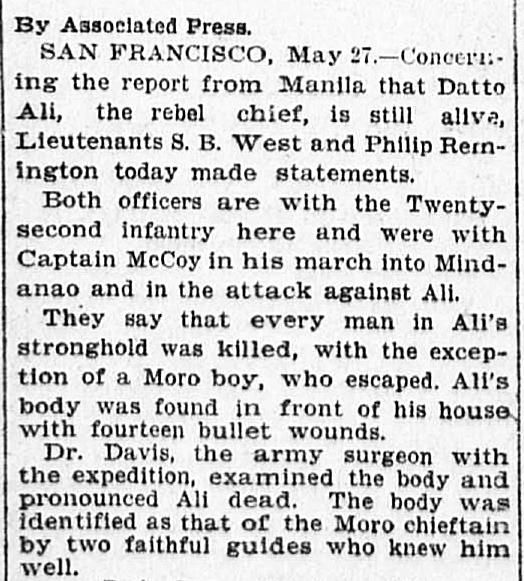
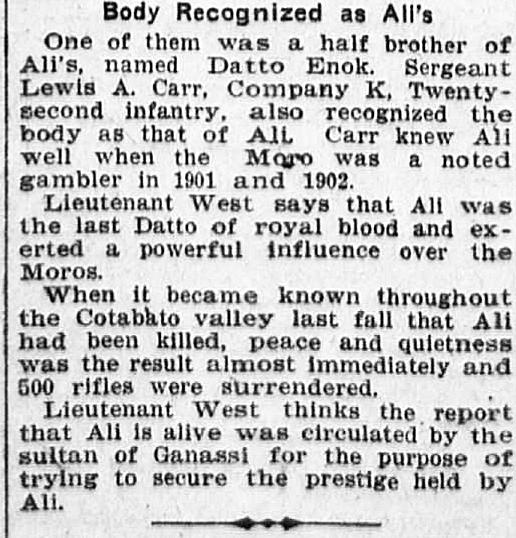
Article from the Los Angeles Herald, Monday, May 28, 1906
CDNC California Digital Newspaper Collection
Since the 22nd Infantry was now
stationed in San Francisco, a newspaper in that city was able to
get a more
detailed account from the two officers of the 22nd Infantry who
were part of the mission, and had seen Ali's body.
1st Lieutenant Solomon B. West and 2nd Lieutenant Philip
Remington were interviewed for the following article.
At the end of the article Remington, ..."who fired the shot
that brought Ali to the ground", remarked that Ali
had been shot ..."in fifteen different places, three bullets
having entered vital organs."
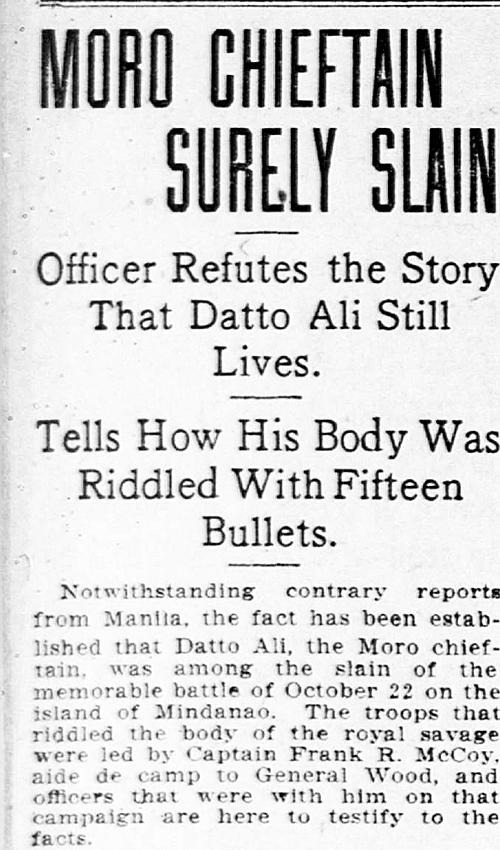
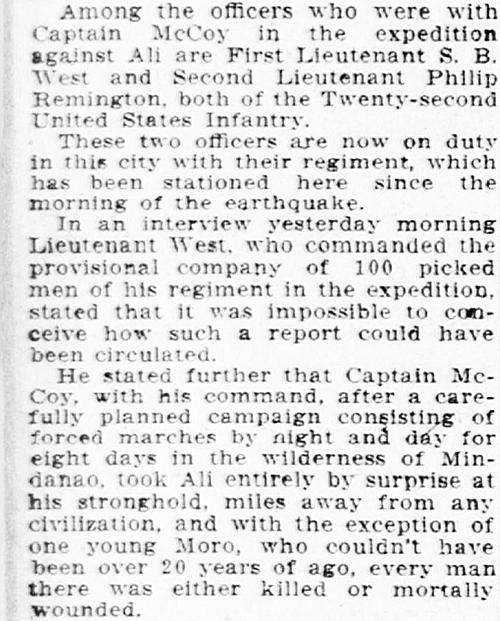
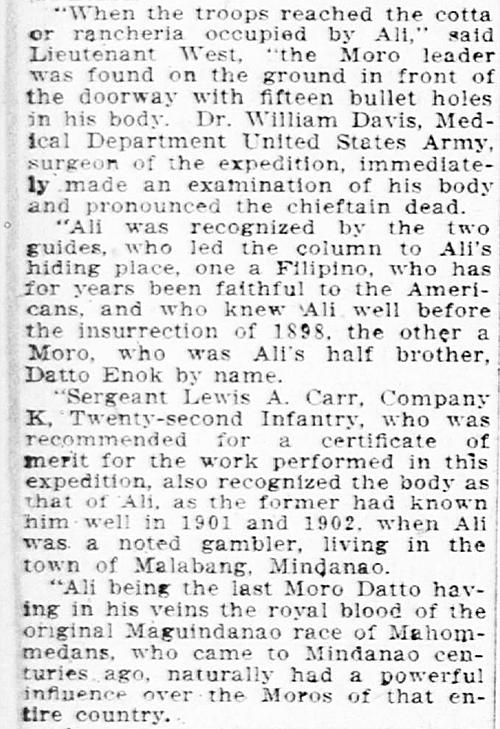
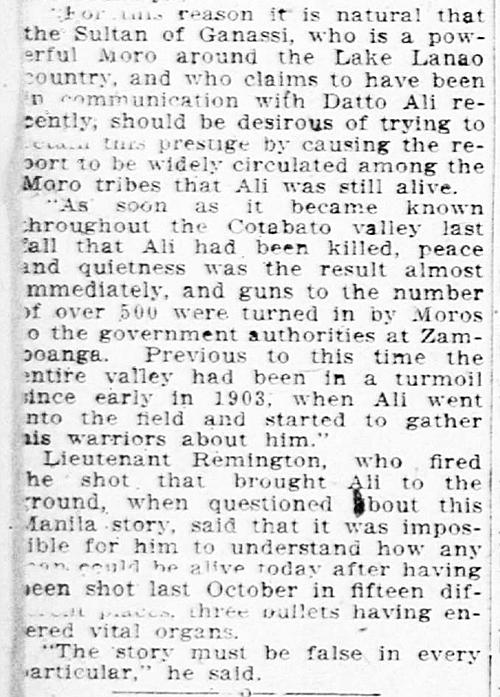
Article from the San Francisco Call, Monday, May 28, 1906
CDNC California Digital Newspaper Collection
Annual Reports of the War
Department for the Fiscal Year ended June 30, 1906,
included this description of the Datu Ali episode:
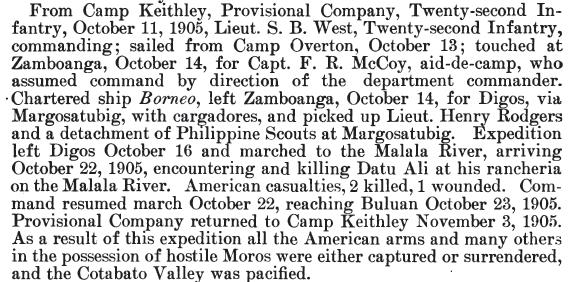
Brigadier General Tasker H. Bliss Commanding Department of Mindinao for the period July 1, 1905 to April 12, 1906
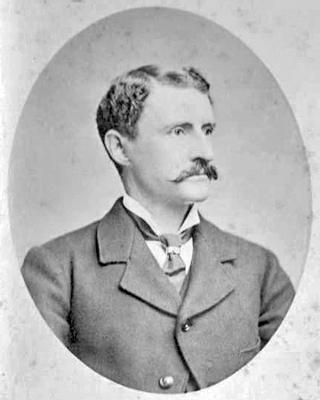
Philip Remington
Undated photo by Amy Griffis from Ancestry.com
In 1923 the Army awarded the
Distinguished Service Cross to 2nd Lieutenant Philip Remington,
for his actions on October 22, 1905, during the expedition which
finally brought an end to Datu Ali.
The citation for that award is below:
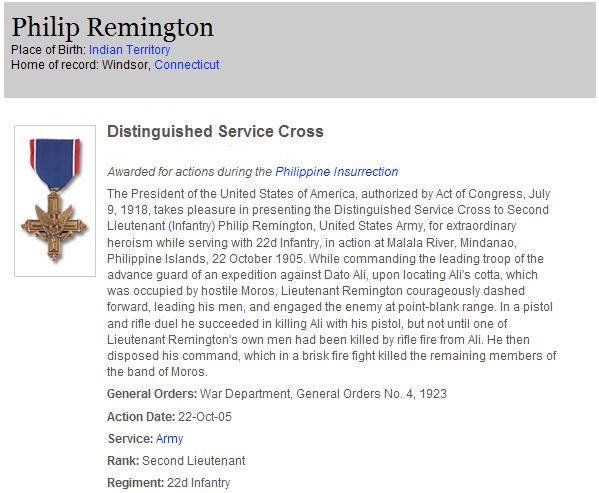
For an account of one of the
22nd Infantry Soldiers who was part of the Provisional Company
which tracked down and killed Datu Ali, go to the following link
on this website:
SGT Grover Hart - Going after the Datu Ali
For an extremely detailed account of the hunt for Datu Ali, see the book:
MOROLAND The History of Uncle Sam
and the Moros 1899-1920
by Robert Fulton
Tumalo Creek Press, Bend, Oregon 2007, 2009
ISBN 978-0-9795173-0-3
Robert Fulton, the author of the
book above, has many photos, maps, and much information
on the pursuit of Datu Ali on his website. Click on the following
link to visit the website:
¹ BULLETS and BOLOS Fifteen Years In The Philippine Islands
by John White
The Century Company, New York & London 1928
Additional sources were:
HISTORY OF THE Twenty-second United States
Infantry 1866-1922
Published by the Regiment 1922
Returns from Regular Army Infantry
Regiments, June 1821–December 1916. NARA microfilm
publication M665
National Archives and Records Administration, Washington, D.C.
Annual Reports of the War Department for
the Fiscal Year Ended June 30, 1904 Volume III
Reports of Division and Department Commanders. Washington:
Government Printing Office 1904
Annual Reports of the War Department for
the Fiscal Year Ended June 30, 1905 Volume III
Reports of Division and Department Commanders. Washington:
Government Printing Office 1905
Register of Enlistments in the U.S. Army, 1798-1914; (National Archives Microfilm Publication M233
Home | Photos | Battles & History | Current |
Rosters & Reports | Medal of Honor | Killed
in Action |
Personnel Locator | Commanders | Station
List | Campaigns |
Honors | Insignia & Memorabilia | 4-42
Artillery | Taps |
What's New | Editorial | Links |